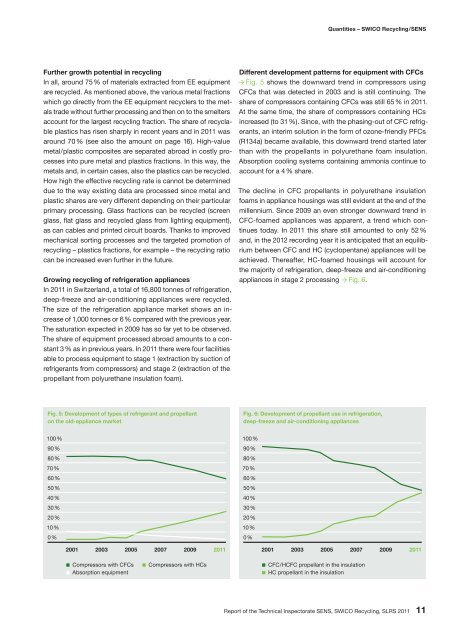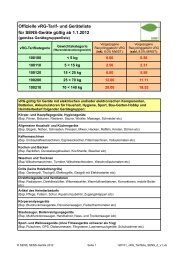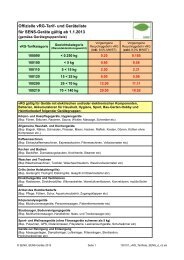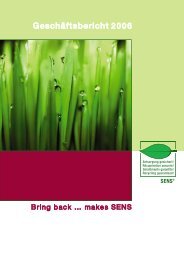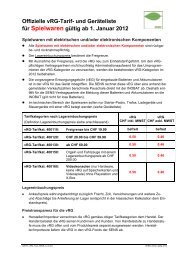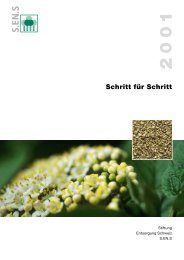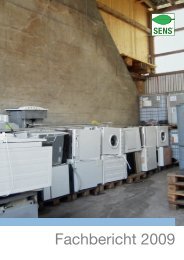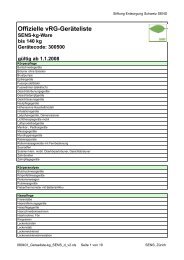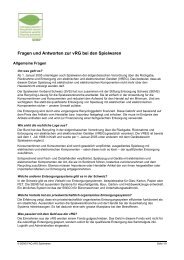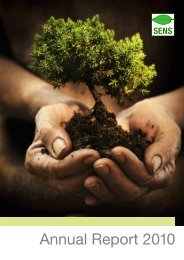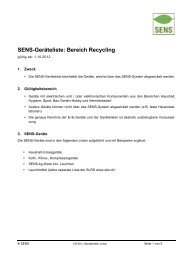Report of the Technical Inspectorate SENS, SWICO Recycling, SLRS
Report of the Technical Inspectorate SENS, SWICO Recycling, SLRS
Report of the Technical Inspectorate SENS, SWICO Recycling, SLRS
Create successful ePaper yourself
Turn your PDF publications into a flip-book with our unique Google optimized e-Paper software.
Fur<strong>the</strong>r growth potential in recycling<br />
In all, around 75 % <strong>of</strong> materials extracted from EE equipment<br />
are recycled. As mentioned above, <strong>the</strong> various metal fractions<br />
which go directly from <strong>the</strong> EE equipment recyclers to <strong>the</strong> metals<br />
trade without fur<strong>the</strong>r processing and <strong>the</strong>n on to <strong>the</strong> smelters<br />
account for <strong>the</strong> largest recycling fraction. The share <strong>of</strong> recyclable<br />
plastics has risen sharply in recent years and in 2011 was<br />
around 70 % (see also <strong>the</strong> amount on page 16). High-value<br />
metal / plastic composites are separated abroad in costly processes<br />
into pure metal and plastics fractions. In this way, <strong>the</strong><br />
metals and, in certain cases, also <strong>the</strong> plastics can be recycled.<br />
How high <strong>the</strong> effective recycling rate is cannot be determined<br />
due to <strong>the</strong> way existing data are processed since metal and<br />
plastic shares are very different depending on <strong>the</strong>ir particular<br />
primary processing. Glass fractions can be recycled (screen<br />
glass, flat glass and recycled glass from lighting equipment),<br />
as can cables and printed circuit boards. Thanks to improved<br />
mechanical sorting processes and <strong>the</strong> targeted promotion <strong>of</strong><br />
recycling – plastics fractions, for example – <strong>the</strong> recycling ratio<br />
can be increased even fur<strong>the</strong>r in <strong>the</strong> future.<br />
Growing recycling <strong>of</strong> refrigeration appliances<br />
In 2011 in Switzerland, a total <strong>of</strong> 16,800 tonnes <strong>of</strong> refrigeration,<br />
deep-freeze and air-conditioning appliances were recycled.<br />
The size <strong>of</strong> <strong>the</strong> refrigeration appliance market shows an increase<br />
<strong>of</strong> 1,000 tonnes or 6 % compared with <strong>the</strong> previous year.<br />
The saturation expected in 2009 has so far yet to be observed.<br />
The share <strong>of</strong> equipment processed abroad amounts to a constant<br />
3 % as in previous years. In 2011 <strong>the</strong>re were four facilities<br />
able to process equipment to stage 1 (extraction by suction <strong>of</strong><br />
refrigerants from compressors) and stage 2 (extraction <strong>of</strong> <strong>the</strong><br />
propellant from polyurethane insulation foam).<br />
Fig. 5: Development <strong>of</strong> types <strong>of</strong> refrigerant and propellant<br />
on <strong>the</strong> old-appliance market<br />
100 %<br />
90 %<br />
80 %<br />
70 %<br />
60 %<br />
50 %<br />
40 %<br />
30 %<br />
20 %<br />
10 %<br />
0 %<br />
2001 2003 2005 2007 2009 2011<br />
Compressors with CFCs Compressors with HCs<br />
Absorption equipment<br />
Quantities – <strong>SWICO</strong> <strong>Recycling</strong> / <strong>SENS</strong><br />
Different development patterns for equipment with CFCs<br />
� Fig. 5 shows <strong>the</strong> downward trend in compressors using<br />
CFCs that was detected in 2003 and is still continuing. The<br />
share <strong>of</strong> compressors containing CFCs was still 65 % in 2011.<br />
At <strong>the</strong> same time, <strong>the</strong> share <strong>of</strong> compressors containing HCs<br />
increased (to 31 %). Since, with <strong>the</strong> phasing-out <strong>of</strong> CFC refrigerants,<br />
an interim solution in <strong>the</strong> form <strong>of</strong> ozone-friendly PFCs<br />
(R134a) became available, this downward trend started later<br />
than with <strong>the</strong> propellants in polyurethane foam insulation.<br />
Absorption cooling systems containing ammonia continue to<br />
account for a 4 % share.<br />
The decline in CFC propellants in polyurethane insulation<br />
foams in appliance housings was still evident at <strong>the</strong> end <strong>of</strong> <strong>the</strong><br />
millennium. Since 2009 an even stronger downward trend in<br />
CFC-foamed appliances was apparent, a trend which continues<br />
today. In 2011 this share still amounted to only 52 %<br />
and, in <strong>the</strong> 2012 recording year it is anticipated that an equilibrium<br />
between CFC and HC (cyclopentane) appliances will be<br />
achieved. Thereafter, HC-foamed housings will account for<br />
<strong>the</strong> majority <strong>of</strong> refrigeration, deep-freeze and air-conditioning<br />
appliances in stage 2 processing � Fig. 6.<br />
Fig. 6: Development <strong>of</strong> propellant use in refrigeration,<br />
deep-freeze and air-conditioning appliances<br />
100 %<br />
90 %<br />
80 %<br />
70 %<br />
60 %<br />
50 %<br />
40 %<br />
30 %<br />
20 %<br />
10 %<br />
0 %<br />
2001 2003 2005 2007 2009 2011<br />
CFC / HCFC propellant in <strong>the</strong> insulation<br />
HC propellant in <strong>the</strong> insulation<br />
<strong>Report</strong> <strong>of</strong> <strong>the</strong> <strong>Technical</strong> <strong>Inspectorate</strong> <strong>SENS</strong>, <strong>SWICO</strong> <strong>Recycling</strong>, <strong>SLRS</strong> 2011 11


